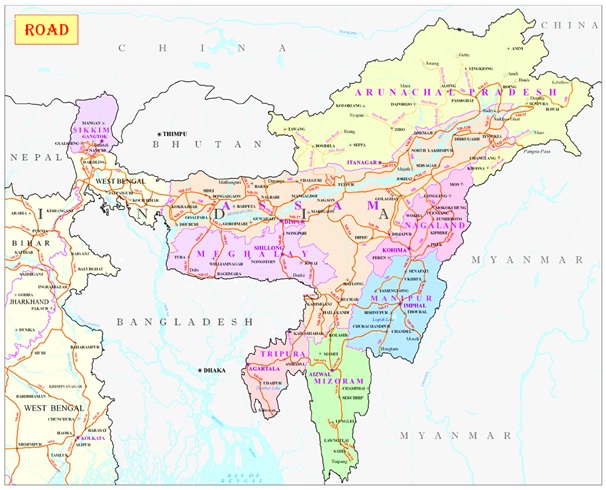
Image courtesy: Ministry
of Development of North Eastern Region
Published on: 02 October 2019
Keywords: Indo-Pacific, Northeast India, Act East Policy, Skilling, Development,
Connectivity
Fragmentation, political isolation, under-development, ethnic conflicts, and insurgencies
(both home-grown and cross-border) have defined Northeast India’s overall
situation in the last few decades. These issues have created several problems for
India’s land-locked Northeastern part since the 1960s. Consequently, Northeast
India has witnessed little growth in the economy and its people have experienced
socio-political-psychological trauma for all these years. Despite having the potential
of becoming India’s natural gateway to Southeast Asia, Northeast India’s
under-development and ethnic conflict-related issues did not allow the region to
be a part of New Delhi’s external policy-making until the early 1990s. This
situation slowly began to change from 1994 when New Delhi embarked on its Look East
Policy which incorporated a change in India’s attitude towards Northeast India.
Gradually, New Delhi started promoting Northeast India as its front door towards
Southeast Asia, which, needs to be opened through cooperation in infrastructure,
connectivity, energy, border trade and business, security and counter-insurgency
operations, to name a few. The signing of the India-Myanmar Border Trade Agreement
in 1994 was the first step towards acknowledging Northeast’s closer geographic
and economic ties with Myanmar, a Southeast Asian country with which India shares
both land and maritime boundaries. The inauguration of the India-Myanmar Friendship
Road, built by India’s Border Roads Organisation (BRO), in 2001 was the second
step towards connecting India’s Northeast with Myanmar. In the last twenty-five
years, since the initiation of India’s Look East Policy, a lot of efforts
have been taken towards establishing closer ties between Northeast India and Southeast
Asia. Sub-regional initiatives like the Bay of Bengal Initiative for Multisectoral
Technical and Economic Cooperation, Bangladesh-China-India-Myanmar Cooperation (BCIM),
and Mekong Ganga Cooperation have contributed to India’s LEP by making it
a prominent and much-discussed policy. However, the question remains, if at all,
India’s Northeast has benefitted from these endeavours.
There have been two interesting developments in India’s external relations
that one can witness in recent years. First, renaming of India’s Look East
Policy as Act East Policy has been done to acknowledge the fact that India needs
to be more proactive not only in Southeast Asia but in East Asia and Oceania regions
as well to adapt to the new realities of geopolitics. Second, the new realities
of geopolitics have replaced the so-called Asia-Pacific with the new notion of Indo-Pacific
where India is expected to play a much stronger role along with the US and its allies
and friends in the region. India has provided its support to this notion of Indo-Pacific
as New Delhi’s ambition of playing the role of a defining actor in the region
has converging interests with countries like US, Australia, Japan, Singapore, Indonesia
and Vietnam. Though ideologically on different paths, cooperation in the maritime
domain, counter-terrorism initiatives, connectivity, economic tie-ups, science and
technology etc. are areas where multilateralism is required. At the same time, the
need to maintain a balance against China’s increasing influence in the region
has been felt by these countries, especially, in the wake of Beijing's assertiveness
in the oceans. A closer look at these two developments in India’s proactive
foreign policy will explicitly indicate synergy between India’s Northeast
with the larger Indo-Pacific region through Southeast Asia. Geographically, Southeast
Asia sits right at the centre of the Indo-Pacific and this can work as leverage
for Northeast India, once it is comprehensively connected with Southeast Asia. This
opening to the Indo-Pacific will bring immense benefits for Northeast India in terms
of investments, transport corridors and energy cooperation. Japan has already decided
to invest
Rs. 13000 crore in the water supply and sewage projects in Assam, Northeast
Road Network Connectivity Improvement Project in Assam and Meghalaya, biodiversity
and forest management projects in Sikkim, Nagaland, and Tripura, and sustainable
agricultural project in Mizoram. This was discussed in June 2019 between Japanese
Ambassador to India, Mr Kenji Hiramatsu and India’s DoNER Minister Dr Jitendra
Singh. In
January 2019, Australia India Travel & Tourism Council has signed an
MoU with Northeast India Tour Operators Association to strengthen tourism connectivity
between Northeast Indian states and Australia. In
February 2019, Bangkok hosted a Northeast India Festival to showcase Northeast
India’s potential and similarities in culture, trade, economy, and tourism
with Thailand. Recently, Singapore has helped Assam government in setting up a
Northeast Skill Centre in Guwahati. All these efforts have given Northeast
India an additional opportunity to be engaged with the neighbouring countries in
the Indo-Pacific and the international forums constructively, something which was
limited to the discussions on its history of conflict until very recently. Additionally,
there are cross-border infrastructural and connectivity projects like the Kaladan
Multimodal Transit and Transport project and India-Myanmar-Thailand Trilateral Highway
which aim at establishing direct linkages between Northeast India and Southeast
Asia. However, the delays in these projects have raised questions about the credibility
of the governments.
Finally, without attaching Northeast India with Southeast Asia and the larger Indo-pacific
region, New Delhi will not be able to accomplish its grand ambition of becoming
a major player in the region. In the last two and half decades, New Delhi has made
several promises to integrate Northeast India with Southeast Asia and partially
fulfilled some of its commitments while others remain sketchy. Therefore, a comprehensive
approach to build up the networks and linkages between Indo-Pacific and Northeast
India is set to benefit New Delhi in ensuring developments within its borders and
create a positive image outside.
Author Information: Dr. Sampa Kundu, Independent Researcher and Consultant.
LinkedIn Profile:
https://www.linkedin.com/in/sampa-kundu-2a526b54/
Disclaimer: The views expressed in this commentary are author's personal observations.